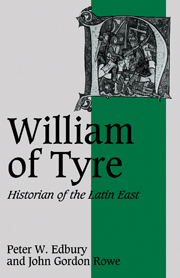Book contents
- Frontmatter
- Contents
- Preface
- Abbreviations and forms of reference
- Introduction
- PART I WILLIAM OF TYRE AND THE WRITING OF THE ‘HISTORIA’
- PART II WILLIAM OF TYRE AND THE MEANING OF THE ‘HISTORIA’
- 5 The monarchy
- 6 Regnum and ecclesia
- 7 The papacy
- 8 The Byzantine empire
- 9 The war against the infidel
- Conclusion
- Bibliography
- Index
- Cambridge studies in medieval life and thought
6 - Regnum and ecclesia
Published online by Cambridge University Press: 09 October 2009
- Frontmatter
- Contents
- Preface
- Abbreviations and forms of reference
- Introduction
- PART I WILLIAM OF TYRE AND THE WRITING OF THE ‘HISTORIA’
- PART II WILLIAM OF TYRE AND THE MEANING OF THE ‘HISTORIA’
- 5 The monarchy
- 6 Regnum and ecclesia
- 7 The papacy
- 8 The Byzantine empire
- 9 The war against the infidel
- Conclusion
- Bibliography
- Index
- Cambridge studies in medieval life and thought
Summary
Just as William of Tyre had views about the monarchy, so too he had views about the Church and the nature of the relationship between priest and king. Although he was well placed to write about the history of the Church in the Latin East, the Historia was not conceived as an ecclesiastical history, and when he did introduce material of ecclesiastical interest it was normally only incidental to his narrative. Indeed, on occasion he in effect admitted that by writing about such matters he had allowed himself to digress from his main purpose. As mentioned already, it seems that William introduced much of his ecclesiastical material at the time he was making his revisions following his attendance at the Third Lateran Council and his realization that his work could be of interest to a clerical audience in western Europe. But, because much of his information on the Church had only a tangential bearing on the main thrust of his political history and may well have been added as something of an afterthought, there are many aspects of the history of its growth and organization which either escape mention altogether or receive only the briefest reference. William, for all his concern with the royal dynasty, nowhere gave any clear indication of the extent of royal control over the Church: we can search the Historia in vain in the hope of discovering whether the kings enjoyed rights of spolia and regalia during episcopal or abbatial vacancies; nor do we find allusions to disputes between the ecclesiastical hierarchy and the secular princes over tithes, even though other evidence survives to prove that such disputes had occurred.
- Type
- Chapter
- Information
- William of TyreHistorian of the Latin East, pp. 85 - 108Publisher: Cambridge University PressPrint publication year: 1988

